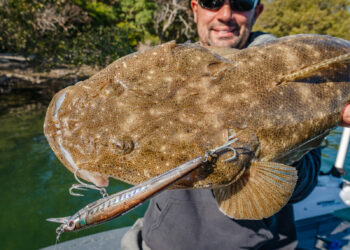ANGLERS who have fished the estuaries and inshore regions of Australia’s tropical north for any length of time are likely to have encountered the blue threadfin or Cooktown salmon, Eleutheronema tetradactylum.
Probably best known as being the smaller cousin of the King threadfin Polydactylus macrochir, the blue threadfin is found in many of the same areas that the king threadfin frequent, but is more common and an exciting sportfish in its own right.
Both species of threadfin are members of the family Polynemidae, a group of fishes adapted to life in muddy water. They have small (but functional) eyes, but have also evolved specialised thread-like “free sensory filaments” at the base of each pectoral fin, from which the name “threadfin” arises. The sensory filaments are likely to have taste buds on them and are used to locate their food, enabling them to feed on prawns, crabs, worms and various types of baitfish quite effectively, even when the water is very dirty. Blue threadfin have three or four shorter filaments per fin, while king threadfin have five longer ones.
Blue threadfin spend their whole life cycle in warm shallow coastal waters and tidal rivers, often in very turbid areas around mangroves, muddy bays and river mouths. Blue threadfin are found throughout the Indo Pacific region from northern Australia and PNG as far east as India and Madagascar. In Australia, blue threadfin are protandrous hermaphrodites like barramundi, i.e. in Western Australia they mature first as males in their first year at 20 cm, then change sex into females at two-three years of age around 40cm long, and grow to around 90cm fork length. However, growth rates vary markedly between regions with fish from Keppel Bay, QLD exhibiting the fastest growth (80cm in around seven years) compared to other regions such as Blue Mud By, NT, where a seven-year-old blue threadfin on average is less than 40cm long. .
Recent genetic studies that have sampled this species from a range of locations across Western Australia, the NT and Queensland have demonstrated that there is complex genetic structure and at least 11 different genetic stocks of blue salmon in different regions. It appears that populations of blue salmon are relatively site attached, backing up tagging and parasite studies that suggest that this species tends not to migrate very far from “home” patches. Juvenile blue threadfin are restricted to estuaries, but tagged adults can move along the coastline for up to 150km. Even then, sometimes adjacent stocks of blue threadfin were separated by only tens of kilometres, even where continuous habitat was present along coastlines with no obvious barriers to mixing. Such was the genetic isolation of the various populations, if individual fish do travel large distances, they must return “home” to breed. This data shows there is some very interesting behaviour going on with blue threadfin.
This species also showed what is called “isolation by distance” whereby the farther apart stocks are from one another, the greater the genetic differences between them. There was also much variability found in the life history characteristics among the different stocks, the aforementioned variation in growth rates being one difference between regions, fish age/length at sex change another. This new information has important management implications as it suggests that blue threadfin are particularly vulnerable to localised depletions, as are king threadfin. This new scientific data suggests that optimal fisheries management of threadfin in Australia may need to be carried out on regional scales much finer than are currently in place.





















